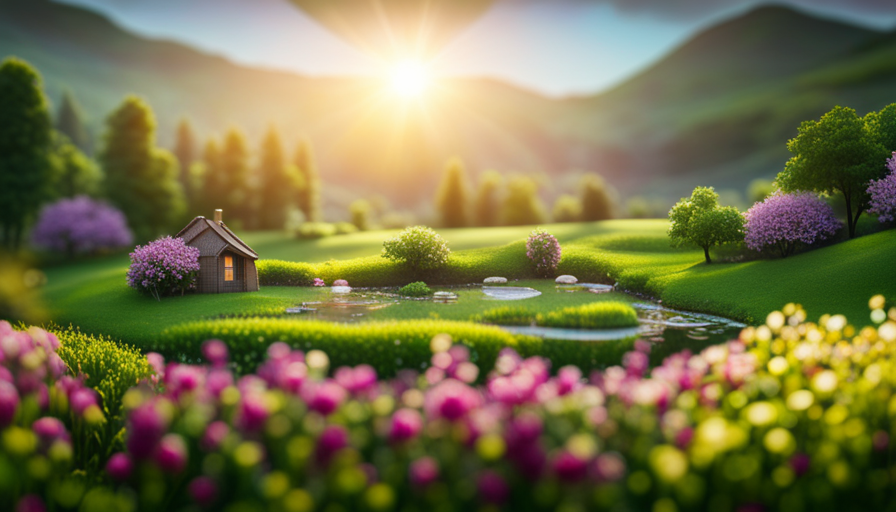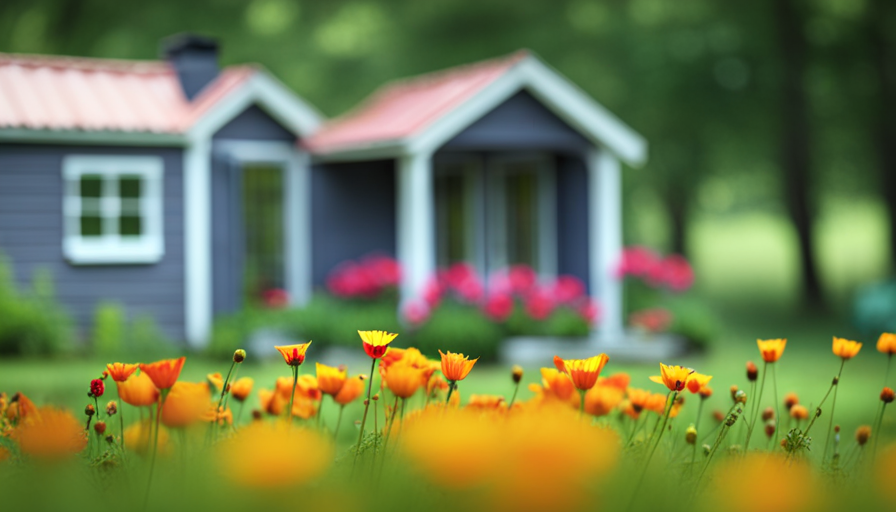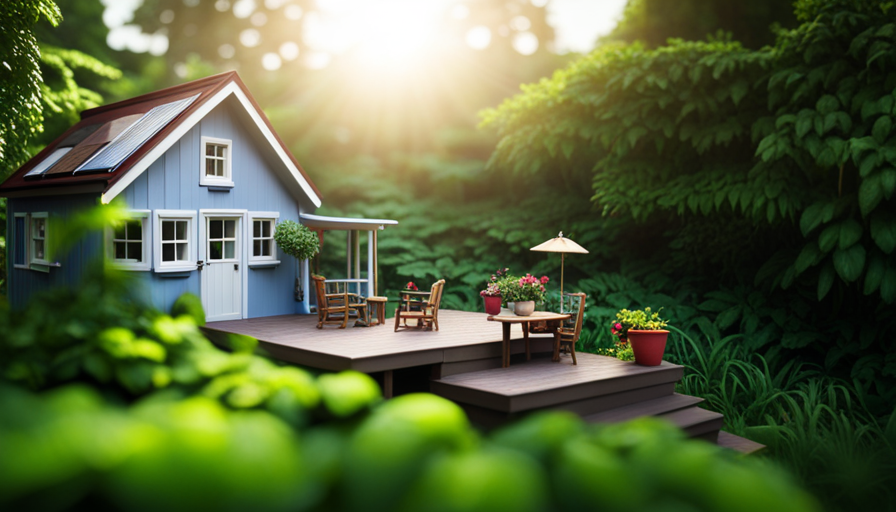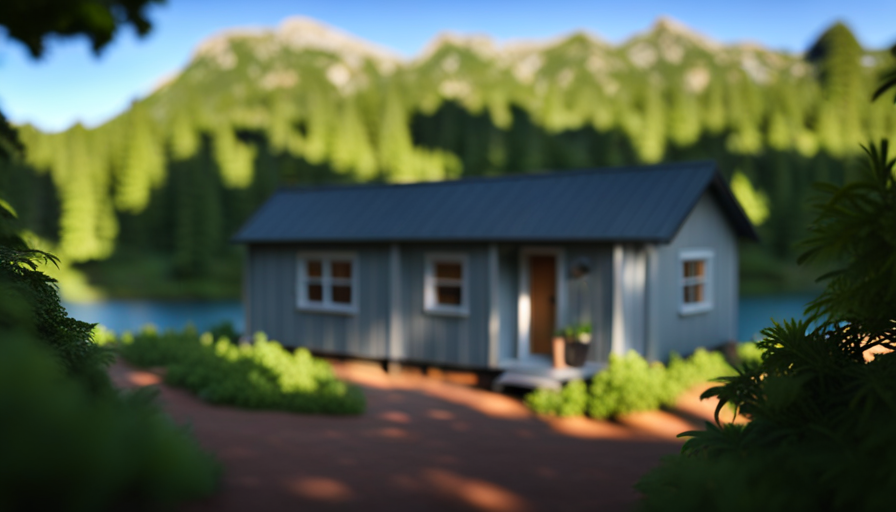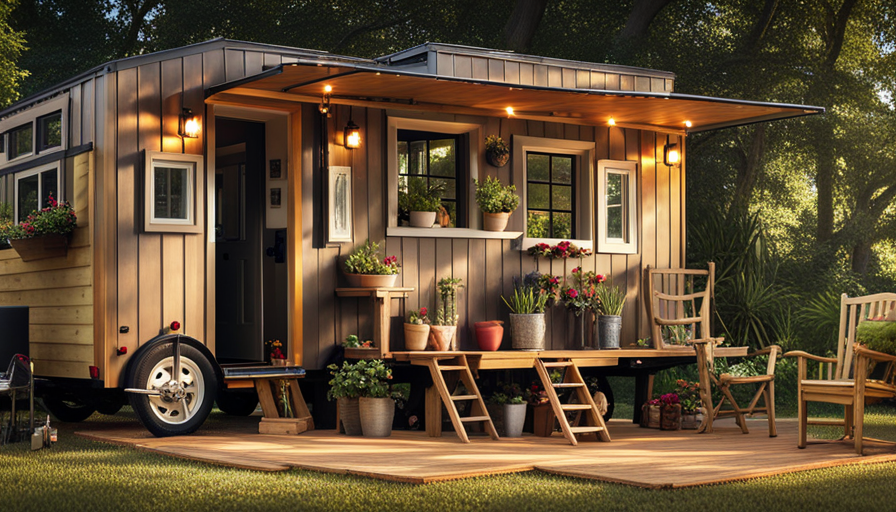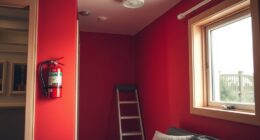Have you ever dreamed of having your own private sanctuary, a unique space that belongs only to you, where you can escape from the busy daily routine? Look no further, as I have the ideal solution for you: a tiny house!
Picture this – a charming, compact dwelling that offers all the comforts of a traditional home, but with a fraction of the size. In this article, I will guide you through the process of acquiring your very own tiny house, step by step.
From researching different designs and styles to understanding zoning regulations, I will provide you with all the necessary information to make your tiny house dreams a reality. Whether you choose to hire a professional builder or take on the challenge of a DIY project, I will help you tailor your tiny house to suit your needs and lifestyle.
So, get ready to embark on an exciting journey towards a simpler, more sustainable way of living. Let’s dive in and discover how you can get your own tiny house!
Key Takeaways
- Tiny houses offer a cozy sanctuary and a simpler, more sustainable way of living.
- Tiny house design trends constantly evolve, offering innovative solutions for maximizing space and functionality.
- Researching the cost and budgeting are crucial for determining the feasibility of owning a tiny house.
- Finding a suitable location for a tiny house requires considering legal aspects and proximity to necessary amenities.
Research Different Tiny House Designs and Styles
If you’re interested in exploring the world of tiny houses, you’ll be amazed at the wide variety of unique designs and styles available to suit your personal taste and needs. Tiny house design trends are constantly evolving, offering innovative solutions for maximizing space and functionality.
From sleek modern designs to rustic cabins, there is a tiny house style for everyone.
One popular trend in tiny house design is the use of creative storage solutions. With limited space, it’s essential to make every inch count. Cleverly designed built-in storage units, hidden compartments, and multi-functional furniture are just a few examples of how tiny house owners can maximize their storage options.
Transitioning into the next section about determining your budget and financing options, it’s important to consider the cost of the different tiny house designs and styles. By researching the various options available, you can choose a design that not only fits your personal style but also aligns with your financial goals.
Determine Your Budget and Financing Options
Once you’ve figured out your financial plan, you’ll be able to unlock the door to your dream of living in a cozy, compact abode. Budgeting is a crucial step in determining the feasibility of owning a tiny house.
Start by evaluating your current income and expenses. Consider how much you can allocate towards your tiny house project without compromising your financial stability. It’s important to create a realistic budget that includes not only the construction costs but also ongoing expenses like utilities, maintenance, and insurance.
Research different financing options available for tiny houses, such as personal loans, RV loans, or even crowdfunding platforms. Compare interest rates, terms, and eligibility criteria to find the option that best suits your needs. Remember to consider the long-term financial implications of each choice.
By carefully budgeting and exploring financing options, you’ll be one step closer to making your tiny house dreams a reality.
When you have determined your budget and financing options, the next step is to find a suitable location for your tiny house.
Find a Suitable Location for Your Tiny House
Discovering the perfect spot for your compact dwelling is an exciting adventure that brings you one step closer to turning your cozy dreams into a reality.
Finding land for your tiny house requires careful consideration of various legal aspects. Firstly, you must determine if you want to buy or lease the land. If you choose to purchase, ensure that the land is suitable for your tiny house’s foundation and utilities. Additionally, consider the location’s proximity to necessary amenities like grocery stores, hospitals, and schools.
It’s crucial to research local zoning laws and building regulations to ensure compliance. Understanding the legal considerations will help you avoid any issues or fines in the future.
Once you have found the perfect location, the next step is to understand zoning and building regulations, which will guide you in making informed decisions about your tiny house.
Understand Zoning and Building Regulations
Navigating the world of zoning and building regulations can feel like deciphering a complex puzzle, but understanding these rules is like having a map that guides you towards your tiny home oasis. It’s crucial to understand permits and the legal restrictions in your area before starting any construction. Here are a few key points to consider:
-
Research local zoning laws: Different areas have different regulations regarding tiny houses. Make sure to research and understand the specific rules in your city or town.
-
Determine if a permit is required: Some places may require a permit for building a tiny house. Check with your local building department to see if you need to obtain one.
-
Compliance with building codes: Ensure that your tiny house meets all the necessary building codes, including electrical, plumbing, and safety regulations.
-
Consider legal restrictions: Some areas have restrictions on where you can park or place a tiny house. Be sure to explore these limitations before choosing a location.
Understanding zoning and building regulations is essential for a successful tiny house project. Once you have a grasp of these rules, you can confidently move forward and explore the next step of hiring a professional builder or considering DIY options.
Hire a Professional Builder or Consider DIY Options
To make your dream of a cozy and unique home a reality, you have two exciting options: hire a professional builder who can bring your vision to life, or take on the rewarding challenge of building a tiny house yourself. Hiring a professional builder offers the advantage of their expertise and experience in constructing tiny houses. They can handle all the technical aspects, from obtaining building permits to ensuring compliance with zoning regulations. On the other hand, if you enjoy getting your hands dirty and have some construction skills, the DIY route can be a fulfilling and cost-effective choice. Building your own tiny house allows for complete customization and the satisfaction of creating something with your own hands. To explore the next step in your tiny house journey, let’s delve into how you can customize your tiny house to fit your needs and lifestyle.
Customize Your Tiny House to Fit Your Needs and Lifestyle
Transforming your cozy haven into a reflection of your unique personality and lifestyle is as simple as adding a touch of your own flair. When it comes to tiny house interior design, maximizing space is key. Here are four ways to customize your tiny house to fit your needs and lifestyle:
-
Multi-functional furniture: Opt for pieces that serve multiple purposes, such as a sofa that can also be used as a bed or storage compartments that double as seating.
-
Smart storage solutions: Utilize vertical space with shelves, hooks, and built-in storage units to keep your belongings organized and maximize every inch of your tiny house.
-
Space-saving appliances: Choose compact appliances that are designed specifically for small spaces, such as a combination washer-dryer or a foldable dining table.
-
Personal touches: Add your own personal style through decor, colors, and textures to make your tiny house feel like home.
By customizing your tiny house to fit your needs and lifestyle, you can fully enjoy the benefits of living in a tiny house that suits you perfectly.
Enjoy the Benefits of Living in a Tiny House
After customizing your tiny house to fit your needs and lifestyle, it’s time to enjoy the benefits of living in a tiny house.
As someone who’s experienced the joys of minimalist living in a tiny house, I can attest to the many advantages it offers. One of the most significant benefits is being a part of a vibrant tiny house community. Living amongst like-minded individuals who appreciate the simplicity and sustainability of tiny living creates a sense of belonging and support.
In these communities, you can share ideas, resources, and even host gatherings to foster meaningful connections. Additionally, minimalist living in a tiny house allows for a more sustainable lifestyle, reducing your ecological footprint and promoting a greener future.
Embracing this lifestyle opens up opportunities for financial freedom, reduced stress, and a focus on experiences rather than material possessions. So, get ready to relish the advantages of living in a tiny house and join a thriving tiny house community today!
Frequently Asked Questions
How much does it cost to build a tiny house?
Building a tiny house can cost anywhere from $10,000 to $100,000, depending on various factors such as size, materials, and location. To minimize costs, consider incorporating efficient tiny house design ideas and tips for maximizing space.
Utilize multifunctional furniture, utilize vertical space, and opt for smart storage solutions. Additionally, using reclaimed materials and DIY techniques can help save money. Remember to plan your budget carefully and consult with professionals to ensure a successful and cost-effective build.
Can I build a tiny house on my own land?
Yes, you can build a tiny house on your own land, but it’s important to understand the building regulations and zoning laws in your area.
These rules vary by location, so it’s crucial to research and comply with them. Building regulations ensure safety and structural integrity, while zoning laws dictate land use and construction requirements.
By familiarizing yourself with these guidelines, you can successfully navigate the process of building a tiny house on your own land.
What are some common challenges when building a tiny house?
When building a tiny house, there are several common challenges to consider. One major hurdle is obtaining the necessary building permits, which vary depending on location and local regulations. It’s crucial to research and adhere to these requirements to ensure compliance and avoid penalties.
Additionally, finding suitable land to build on can be a challenge, as zoning laws and restrictions may limit where you can construct your tiny house. Thoroughly researching and understanding these challenges is essential for a successful tiny house build.
Are there any restrictions on the size of a tiny house?
Tiny house size regulations and zoning restrictions vary depending on the location. Many cities have specific guidelines for tiny homes, including minimum and maximum square footage requirements. Some areas may require a minimum size to ensure habitability, while others impose restrictions to maintain the character of the neighborhood.
Zoning restrictions may dictate where a tiny house can be placed, such as in a designated tiny house community or as an accessory dwelling unit on a property.
How long does it take to build a tiny house?
The construction process and building timeline for a tiny house can vary depending on several factors. Generally, it takes about 2-4 months to build a tiny house.
This timeline includes the planning and design phase, obtaining necessary permits, and the actual construction. The construction process involves tasks such as framing, roofing, electrical and plumbing installations, and interior finishing.
It’s important to have a clear plan and consult with professionals to ensure a smooth and efficient building process.
Conclusion
In conclusion, after extensive research and careful consideration, I’ve successfully acquired my dream tiny house.
By exploring various designs and styles, I was able to find the perfect fit for my needs and lifestyle.
Determining my budget and exploring financing options allowed me to secure the necessary funds.
Additionally, understanding zoning regulations and finding a suitable location were crucial steps in the process.
Whether you choose to hire a professional builder or embark on a DIY journey, customizing your tiny house is a rewarding experience.
Now, I’m reaping the benefits of living in my cozy and efficient abode.
As they say, "Good things come in small packages."
Hi, I’m Emma. I’m the Editor in Chief of Tiny House 43, a blog all about tiny houses. While tree houses are often associated with childhood, they can be the perfect adult retreat. They offer a cozy space to relax and unwind, surrounded by nature. And since they’re typically built on stilts or raised platforms, they offer stunning views that traditional homes simply can’t match. If you’re looking for a unique and romantic getaway, a tree house tiny house might just be the perfect option.
